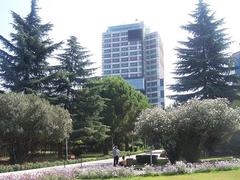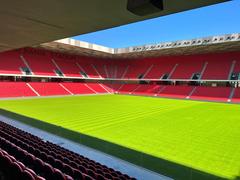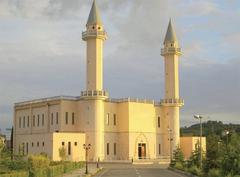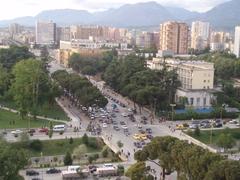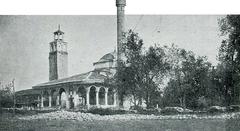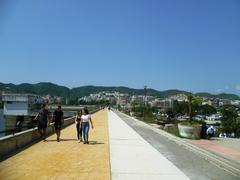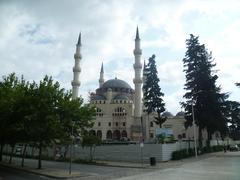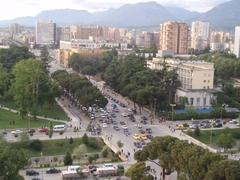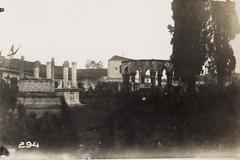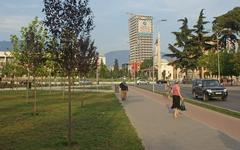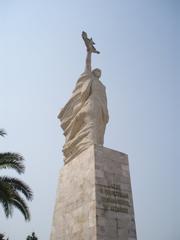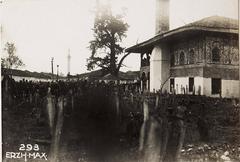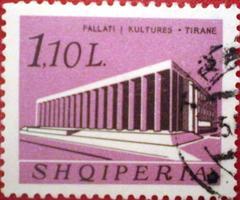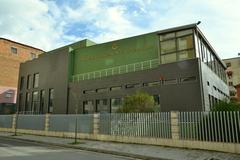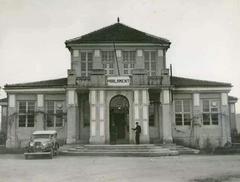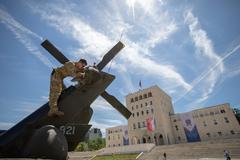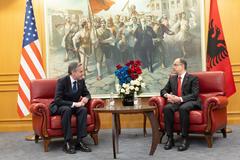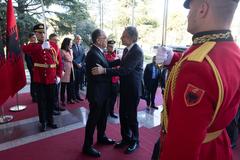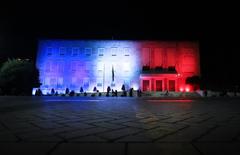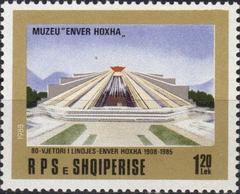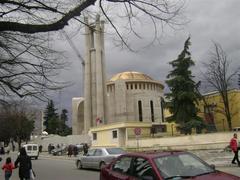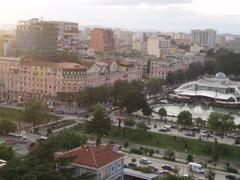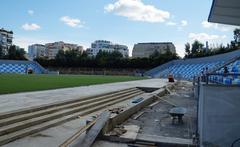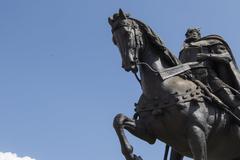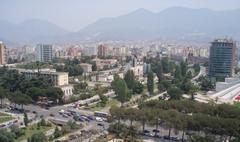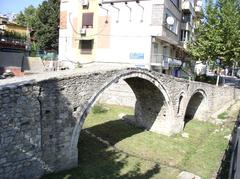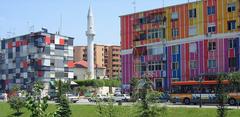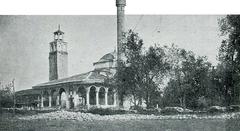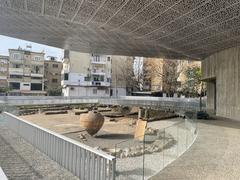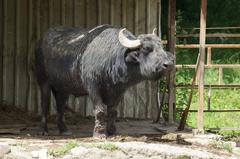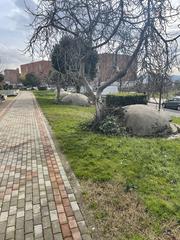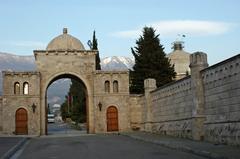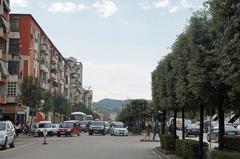Saint Procopius Church Tirana: Visiting Hours, Tickets, and History Guide
Date: 15/06/2025
Introduction
Saint Procopius Church (Kisha e Shën Prokopit) is a significant Orthodox Christian landmark in Tirana, Albania, representing both the city’s spiritual heritage and its historical resilience. Its origins, architectural evolution, and ongoing role in the community make it an essential destination for travelers interested in Albania’s religious and cultural tapestry. This detailed guide covers the church’s history, architecture, visiting logistics, community significance, and practical travel tips to ensure a rewarding visit.
Table of Contents
- Overview and Historical Timeline
- Origins and Early History
- Urban Transformation and Relocation
- Architectural Features and Restoration
- Survival During the Communist Era
- Post-Communist Revival
- Artistic and Liturgical Details
- Visiting Information: Hours, Tickets, and Accessibility
- Nearby Attractions and Suggested Itineraries
- Community Life and Events
- FAQs
- Conclusion and Travel Resources
Overview and Historical Timeline
Saint Procopius Church’s history traces the endurance of Tirana’s Orthodox community, from its late 18th-century foundation under Ottoman rule—when Christian churches were often built partially underground—to its demolition and relocation during the city’s modernization in the 20th century, its suppression under communism, and its revival after the regime’s fall (Wikipedia). The church is not only a religious center but also a testament to the city’s dynamic urban and social developments (tirana.al; tiranatriennale.com).
Origins and Early History
Constructed between 1790 and 1797, the original Saint Procopius Church was established with the patronage of the Bargjini family as a reward for the Orthodox community’s defense of Tirana (Wikipedia). Ottoman-era restrictions required Christian buildings to be low-profile, so the church was partially built underground. For nearly a century, it served as a spiritual hub for the Orthodox population, with its codex maintained in Greek.
Urban Transformation and Relocation
The late 19th and early 20th centuries brought urban changes to Tirana. With the construction of new religious buildings such as the Evangelismos Church in 1874, the focus of Orthodox worship shifted. In the 1920s, the original Saint Procopius Church was demolished to accommodate a grand boulevard under President Ahmet Zogu’s modernization plan (tirana.al). The congregation relocated to Lake Hill near the Grand Park, where the current church stands (tiranatriennale.com).
Architectural Features and Restoration
The present church, designed by Skënder Luarasi between 1937 and 1940, features a post-Byzantine style typical of the southwestern Balkans. Notable for its cross-in-square plan, central dome, and use of reinforced concrete, the building harmonizes traditional Orthodox forms with modern construction techniques (visit-tirana.com). The church was consecrated in 1945 and showcases locally sourced stone, arched windows, a modest dome, and a bell tower (Evendo).
Ongoing restoration efforts ensure the preservation of its architectural, artistic, and spiritual heritage, including the maintenance of the iconostasis, frescoes, and gardens (Wikipedia).
Survival During the Communist Era
Under Enver Hoxha’s communist regime, Albania became the world’s first officially atheist state. Religious institutions were closed or repurposed; Saint Procopius Church was converted into a bar and restaurant, losing its sacred function but surviving structurally (orthochristian.com).
Post-Communist Revival
Following the end of communism, the church was reclaimed and restored by Tirana’s Orthodox community. Reconsecrated in 1993, it underwent further legal and physical restoration. In July 2023, the Albanian state officially returned the church and its land to the Orthodox Church, enabling full restoration and the development of new community facilities (tiranapost.al).
Artistic and Liturgical Details
Exterior Features
Saint Procopius Church’s exterior blends local stone and brick with traditional Orthodox design. The modest dome, arched entrances, and bell tower are defining features. The landscaped gardens offer a tranquil setting for visitors (Evendo).
Interior and Iconography
The nave leads to a sanctuary separated by a richly decorated iconostasis, featuring icons of Christ, the Virgin Mary, Saint Procopius, and other saints, often arranged hierarchically in traditional Orthodox style. Vivid frescoes and wall paintings depict biblical stories and the lives of saints. The sanctuary contains the altar, bishop’s throne, and liturgical furnishings, combining artistry with function (Wikipedia).
Liturgical Life
Saint Procopius Church regularly hosts Orthodox services, sacraments, and religious celebrations, especially on the feast day of its patron saint in July. The church also organizes community outreach and charitable programs (Orthodox World).
Visiting Information: Hours, Tickets, and Accessibility
Location: Lake Hill near the Grand Park of Tirana. Easily accessible by taxi, bus, or on foot from central Tirana.
Visiting Hours:
- Monday to Saturday: 9:00 AM – 5:00 PM
- Sunday: 12:00 PM – 6:00 PM (after Divine Liturgy)
- Hours may vary during religious holidays; check the Orthodox Church of Albania or at the church entrance for updates.
Tickets: Admission is free. Donations are encouraged to support restoration.
Guided Tours: Available upon request through the church or Tirana’s Tourist Information Centre. English-speaking guides can be arranged.
Accessibility: The church and gardens are wheelchair accessible, with ramps and staff assistance available if needed.
Photography: Permitted outside the church; for interior photography, ask for permission and avoid flash during services.
Visitor Etiquette: Dress modestly, cover shoulders and knees, and be respectful during religious services.
Nearby Attractions and Suggested Itineraries
Saint Procopius Church is close to several major Tirana landmarks:
- Et’hem Bey Mosque: Notable Ottoman-era mosque.
- Skanderbeg Square: Central Tirana plaza and cultural hub.
- Grand Park of Tirana: Ideal for walks and relaxation.
- National Archaeological Museum: Albania’s largest collection of artifacts.
- Ish-Blloku District: Lively area for dining and nightlife.
Suggested itinerary: Morning visit to the church, a stroll through Grand Park, exploration of the National Archaeological Museum, and a meal in the Ish-Blloku district.
Community Life and Events
The church serves as an active hub for Orthodox worship, sacraments, and feast-day celebrations. Community outreach programs, such as “Lighten the Church” and “Support a Holy Cause,” encourage social engagement and charitable giving (Orthodox World).
Frequently Asked Questions (FAQ)
Q: What are the visiting hours?
A: Monday–Saturday 9:00 AM–5:00 PM; Sunday 12:00 PM–6:00 PM. Check for holiday variations.
Q: Is there an entrance fee?
A: No, entry is free. Donations are appreciated.
Q: Is the church accessible for those with disabilities?
A: Yes, the church is wheelchair accessible.
Q: Are guided tours available?
A: Yes, arrange in advance via the church or local tourist office.
Q: Can I take photos inside?
A: Ask permission for interior photography, especially during services.
Q: What other attractions are nearby?
A: Grand Park, Et’hem Bey Mosque, Skanderbeg Square, National Archaeological Museum.
Conclusion and Travel Resources
Saint Procopius Church stands as a powerful symbol of faith, resilience, and cultural continuity in Tirana. Its rich history—from Ottoman-era origins and survival through communism to post-communist revival—offers visitors a compelling glimpse into Albania’s spiritual landscape. With free admission, accessible facilities, and proximity to other landmarks, the church is a rewarding addition to any Tirana itinerary.
For up-to-date information, guided tour bookings, and travel tips, consult the church’s official channels and download the Audiala app. Discover more about Albania’s Orthodox heritage and Tirana’s historical sites by exploring our related articles and local tourism resources.
For further reading and planning, see:
- Saint Procopius Church of Tirana (Wikipedia)
- Heritage and Architectural Evolution in Tirana (tirana.al)
- Church of Saint Procopius (tiranatriennale.com)
- Tirana: A Model of Religious Tolerance (visit-tirana.com)
- Saint Procopius Church Restoration (orthochristian.com)
- Nis rindërtimi i Kishës së Shën Prokopit (tiranapost.al)
- St Procopius Church Tirana (Evendo)
- Saint Procopius Orthodox Church (Orthodox World)
- Things To Do in Tirana (My Wanderlust)
- Free Things to Do in Tirana (JJ Bucket List Travellers)
- Tirana Tourist Information (HikersBay)
- Official Visit Tirana
